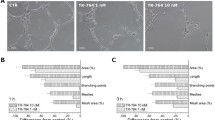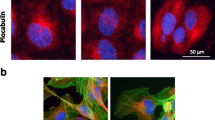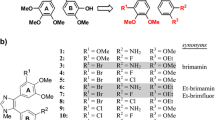Summary
Peloruside A is a microtubule-stabilizing agent that is currently under investigation as a potential anticancer agent. Peloruside A binds to a site on β-tubulin that is distinct to that of the taxanes (paclitaxel and docetaxel) and the epothilones. An attractive clinical quality of microtubule-stabilizing agents is their ability to target multiple mechanisms of tumour growth. In addition to inducing tumour cell apoptosis by arresting cells in mitosis, microtubule-stabilizing agents also inhibit angiogenesis, a process needed by tumor cells for growth and metastasis. In this study, the effects of peloruside A on endothelial cell processes important for angiogenesis were assessed in comparison to docetaxel. Both peloruside A and docetaxel potently inhibited the proliferation of human umbilical vein endothelial cells, with IC50 values of 1.4 and 1.7 nM, respectively. Peloruside also potently blocked endothelial cell migration during wound closure and the three-dimensional organization of the endothelial cells into capillary-like tubes. In the wound scratch assay, peloruside A inhibited wound recovery with an IC50 of 6.3 nM after 18 h. Docetaxel was approximately 3-fold more potent than peloruside A. The number of capillary-like tubes that formed after 16 h culture in Matrigel™ was also inhibited in a dose-dependent manner with an IC50 of 4.5 nM. Docetaxel was about 2-fold more potent than peloruside A in preventing tube formation. This inhibition of endothelial cell function occurred at relatively non-cytotoxic concentrations over the 16–18 h incubations for both stabilizing agents, suggesting that anti-angiogenic effects are likely to occur before therapeutically relevant doses begin to inhibit tumor growth or adverse side effects develop.





Similar content being viewed by others

Abbreviations
- Dtx:
-
Docetaxel
- EC:
-
Endothelial cell
- HUVEC:
-
Human umbilical vein endothelial cell
- PelA:
-
Peloruside A
- MSA:
-
Microtubule-stabilizing agent
- MTA:
-
Microtubule-targeting agent
- MTT:
-
2-(4,5-dimethyl-2-thiazolyl)-3,5-diphenyl-2H-tetrazolium bromide
- VEGF:
-
Vascular endothelial growth factor
References
Folkman J (1971) Tumor angiogenesis: therapeutic implications. N Engl J Med 285:1182–1186
Eichhorn M, Kleespies A, Angele M, Jauch KW, Bruns C (2007) Angiogenesis in cancer: molecular mechanisms, clinical impact. Langenbecks Arch Surg 392:371–379
Hurwitz H, Fehrenbacher L, Novotny W, Cartwright T, Hainsworth J, Heim W, Berlin J, Baron A, Griffing S, Holmgren E, Ferrara N, Fyfe G, Rogers B, Ross R, Kabbinavar F (2004) Bevacizumab plus irinotecan, fluorouracil, and leucovorin for metastatic colorectal cancer. N Engl J Med 350:2335–2342
Bocci G, Nicolaou KC, Kerbel RS (2002) Protracted low-dose effects on human endothelial cell proliferation and survival in vitro reveal a selective antiangiogenic window for various chemotherapeutic drugs. Cancer Res 62:6938–6943
Kerbel R, Folkman J (2002) Clinical translation of angiogenesis inhibitors. Nat Rev Cancer 2:727–739
Folkman J (2007) Angiogenesis: an organizing principle for drug discovery? Nat Rev Drug Discov 6:273–286
Jordan MA, Wilson L (2004) Microtubules as a target for anticancer drugs. Nat Rev Cancer 4:253–265
Rowinsky EK (1997) The development and clinical utility of the taxane class of antimicrotubule chemotherapy agents. Annu Rev Med 48:353–374
Kaiser S, Muller JJ, Froehlich PE, Baggio Gnoatto SC, Bergold AM (2013) From bacteria to antineoplastic: epothilones a successful history. Anticancer Agents Med Chem 13:1057–1068
Rohena CC, Mooberry SL (2014) Recent progress with microtubule stabilizers: new compounds, binding modes and cellular activities. Nat Prod Rep 31:335–355
Kingston DG, Snyder JP (2014) The quest for a simple bioactive analog of paclitaxel as a potential anticancer agent. Acc Chem Res 47:2682–2691
Ogden A, Rida PCG, Reid MD, Aneja R (2013) Interphase microtubules: chief casualties in the war on cancer? Drug Discov Today 19:824–829
Field JJ, Kanakkanthara A, Miller JH (2014) Microtubule-targeting agents are clinically successful due to both mitotic and interphase impairment of microtubule function. Bioorg Med Chem 22:5050–5059
Belotti D, Vergani V, Drudis T, Borsotti P, Pitelli MR, Viale G, Giavazzi R, Taraboletti G (1996) The microtubule-affecting drug paclitaxel has antiangiogenic activity. Clin Cancer Res 2:1843–1849
Bijman MNA, van Nieuw Amerongen GP, Laurens N, van Hinsbergh VWM, Boven E (2006) Microtubule-targeting agents inhibit angiogenesis at subtoxic concentrations, a process associated with inhibition of Rac1 and Cdc42 activity and changes in the endothelial cytoskeleton. Mol Cancer Ther 5:2348–2357
Ganguly A, Yang H, Zhang H, Cabral F, Patel KD (2013) Microtubule dynamics control tail retraction in migrating vascular endothelial cells. Mol Cancer Ther 12:2837–2846
Hotchkiss KA, Ashton AW, Mahmood R, Russell RG, Sparano JA, Schwartz EL (2002) Inhibition of endothelial cell function in vitro and angiogenesis in vivo by docetaxel (Taxotere): association with impaired repositioning of the microtubule organizing center. Mol Cancer Ther 1:1191–1200
Kanakkanthara A, Teesdale-Spittle PH, Miller JH (2013) Cytoskeletal alterations that confer resistance to anti-tubulin chemotherapeutics. Anti Cancer Agents Med Chem 13:147–158
West LM, Northcote PT, Battershill CN (2000) Peloruside A: a potent cytotoxic macrolide isolated from the New Zealand marine sponge Mycale sp. J Org Chem 65:445–449
Hood KA, West LM, Rouwé B, Northcote PT, Berridge MV, Wakefield SJ, Miller JH (2002) Peloruside A, a novel antimitotic agent with paclitaxel-like microtubule stabilizing activity. Cancer Res 62:3356–3360
Pryor DE, O'Brate A, Bilcer G, Díaz JF, Wang YF, Wang Y, Kabaki M, Jung MK, Andreu JM, Ghosh AK, Giannakakou P, Hamel E (2002) The microtubule stabilizing agent laulimalide does not bind in the taxoid site, kills cells resistant to paclitaxel and epothilones, and may not require its epoxide moiety for activity. Biochemistry 41:9109–9115
Gaitanos TN, Buey RM, Díaz F, Northcote PT, Spittle PT, Andreu JM, Miller JH (2004) Peloruside A does not bind to the taxoid site on β-tubulin and retains its activity in multidrug-resistant cell lines. Cancer Res 64:5063–5067
Prota AE, Bargsten K, Northcote PT, Marsh M, Altmann K-H, Miller JH, Díaz JF, Steinmetz MO (2014) Structural basis of microtubule stabilization by laulimalide and peloruside A. Angew Chem Int Ed 53:1621–1625
Lu H, Murtagh J, Schwartz EL (2006) The microtubule binding drug laulimalide inhibits vascular endothelial growth factor-induced human endothelial cell migration and is synergistic when combined with docetaxel (Taxotere). Mol Pharmacol 69:1207–1215
Hood KA, Bäckström BT, West LM, Northcote PT, Berridge MV, Miller JH (2001) The novel cytotoxic sponge metabolite peloruside A, structurally similar to bryostatin-1, has unique bioactivity independent of protein kinase C. Anticancer Drug Des 16:155–166
Kamath K, Smiyun S, Wilson L, Jordan MA (2014) Mechanisms of inhibition of endothelial cell migration by taxanes. Cytoskeleton 71:46–60
Chan A, Andreae P, Northcote PT, Miller JH (2011) Peloruside A inhibits microtubule dynamics in a breast cancer cell line MCF7. Investig New Drugs 29:615–626
Crume KP, Miller JH, La Flamme AC (2007) Peloruside A, an anti-mitotic agent, specifically decreases TNF-α production by LPS-stimulated murine macrophages. Exp Biol Med 232:607–613
Watters JW, Kraja A, Meucci MA, Province MA, McLeod HL (2004) Genome-wide discovery of loci influencing chemotherapy cytotoxicity. Proc Natl Acad Sci U S A 101:11809–11814
Wilmes A, O’Sullivan D, Chan A, Chandrahasen C, Paterson I, Northcote PT, La Flamme AC, Miller JH (2011) Synergistic interactions between peloruside A and other microtubule-stabilizing and destabilizing agents in cultured human ovarian carcinoma cells and murine T cells. Cancer Chemother Pharmacol 68:117–126
Sánchez-Moreno P, Boulaiz H, Ortega-Vinuesa JL, Peula-García JM, Aránega A (2012) Novel drug delivery system based on docetaxel-loaded nanocapsules as a therapeutic strategy against breast cancer cells. Int J Mol Sci 13:4906–4919
Tsakalozou E, Eckman AM, Bae Y (2012) Combination effects of docetaxel and doxorubicin in hormone-refractory prostate cancer cells. Biochem Res Int 2012:832059. doi:10.1155/2012/832059
Schwartz EL (2009) Antivascular actions of microtubule-binding drugs. Clin Cancer Res 15:2594–2601
Kaverina I, Straube A (2011) Regulation of cell migration by dynamic microtubules. Semin Cell Dev Biol 22:968–974
Watanabe T, Noritake J, Kaibuchi K (2005) Regulation of microtubules in cell migration. Trends Cell Biol 15:76–83
Wilmes A, Rawson P, Peng L, McLauchlan D, Northcote PT, Jordan TW, Miller JH (2011) Effects of the microtubule stabilizing agent peloruside A on the proteome of HL-60 cells. Investig New Drugs 29:544–553
Wilmes A, Chan A, Rawson P, Jordan TW, Miller JH (2012) Paclitaxel effects on the proteome of HL-60 promyelocytic leukemic cells: comparison to peloruside A. Investig New Drugs 30:121–129
Honore S, Kamath K, Braguer D, Wilson L, Briand C, Jordan MA (2003) Suppression of microtubule dynamics by discodermolide by a novel mechanism is associated with mitotic arrest and inhibition of tumor cell proliferation. Mol Cancer Ther 2:1303–1311
Murtagh J, Lu H, Schwartz EL (2006) Taxotere-induced inhibition of human endothelial cell migration is a result of heat shock protein 90 degradation. Cancer Res 66:8192–8199
Even-Ram S, Doyle AD, Conti MA, Matsumoto K, Adelstein RS, Yamada KM (2007) Myosin IIA regulates cell motility and actomyosin-microtubule crosstalk. Nat Cell Biol 9:299–309, Erratum: Nat Cell Biol 2007 9:480
Etienne-Manneville S (2004) Actin and microtubules in cell motility: which one is in control? Traffic 5:470–477
Akhmanova A, Stehbens SJ, Yap AS (2009) Touch, grasp, deliver and control: functional cross-talk between microtubules and cell adhesions. Traffic 10:268–274
Byron A, Askari JA, Humphries JD, Jacquemet G, Koper EJ, Warwood S, Choi CK, Stroud MJ, Chen CS, Knight D, Humphries MJ (2015) A proteomic approach reveals integrin activation state-dependent control of microtubule cortical targeting. Nat Commun 6:6135. doi:10.1038/ncomms7135
Yang H, Ganguly A, Cabral F (2010) Inhibition of cell migration and cell division correlates with distinct effects of microtubule inhibiting drugs. J Biol Chem 285:32242–32250
Hayot C, Farinelle S, De Decker R, Decaestecker C, Darro F, Kiss R, Van Damme M (2002) In vitro pharmacological characterizations of the anti-angiogenic and anti-tumor cell migration properties mediated by microtubule-affecting drugs, with special emphasis on the organization of the actin cytoskeleton. Int J Oncol 21:417–425
Acknowledgments
The authors would like to thank Dr Sarah Gunningham (Mackenzie Cancer Research Group, University of Canterbury) for providing the HUVECs, Craig Doney (VUW) for making the wound scratch assay plate insert, and Pan Xiaotao (Media Cybernetics) for creating the Image-Pro Plus semi-automated macro method. Ariane Chan was funded by a PhD scholarship awarded by the Genesis Oncology Trust. Additional funding was provided by the Wellington Medical Research Foundation, the Cancer Society of New Zealand, and Victoria University of Wellington.
Ethical statement
No ethical approval was required for the completion of this study, as no animal or human experiments were involved.
Conflict of interest
PT Northcote and JH Miller are named on a US patent for peloruside A.
Author information
Authors and Affiliations
Corresponding author
Rights and permissions
About this article
Cite this article
Chan, A., Singh, A.J., Northcote, P.T. et al. Inhibition of human vascular endothelial cell migration and capillary-like tube formation by the microtubule-stabilizing agent peloruside A. Invest New Drugs 33, 564–574 (2015). https://doi.org/10.1007/s10637-015-0232-8
Received:
Accepted:
Published:
Issue Date:
DOI: https://doi.org/10.1007/s10637-015-0232-8



